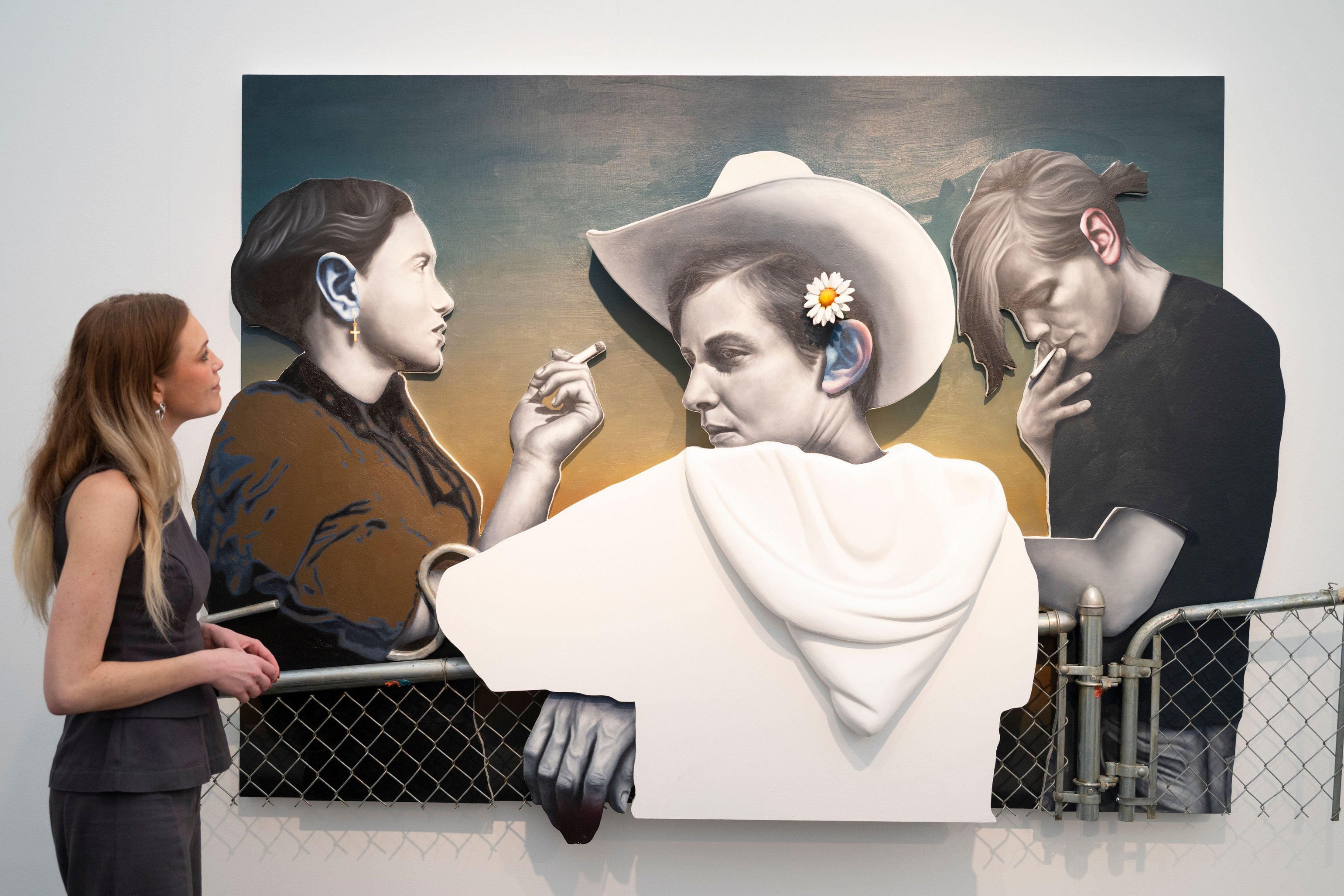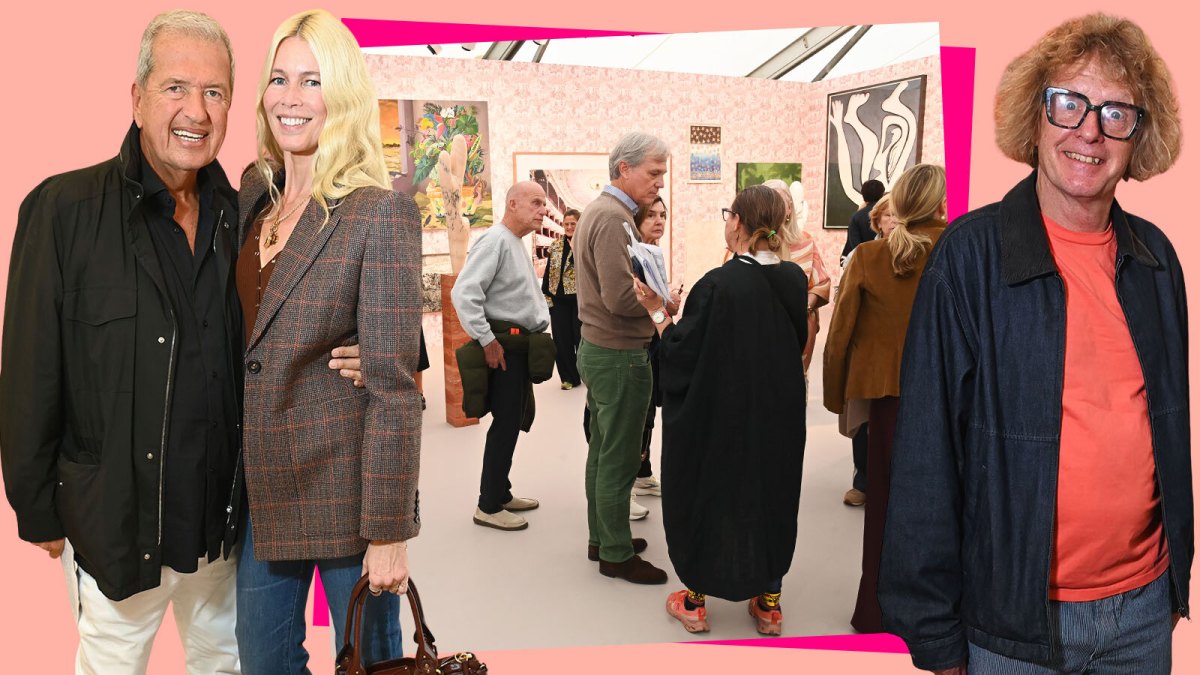I was expecting a lot more fashion. For the past few years the VIP day at Frieze art fair has been a wild ride of eccentric outfits, startling cosmetic enhancements and super-sexy art.
This year there is a decent share of the latter, as Frieze London and Frieze Masters kick off — the one contemporary, the other less so, each a short walk from the other — and not just in the pearl-clutching sense. That said, a charcoal drawing of a naked woman behind bars, by Saskia Colwell at Victoria Miro gallery’s booth, has a spicy vibe, as does the terracotta sculpture of a flaccid male member dating from around 500BC that protrudes limply from the wall at Charles Ede’s booth.
But the Instagrammable madness that characterised Frieze in the heyday of the art boom is conspicuously absent. It’s a good thing, says one gallery director, who declines to be named. “A few years ago they were giving away so many free VIP tickets, it was ridiculous,” he says. “This year it feels like they’ve learnt from that mistake — the crowd is a bit more glam. They actually feel like VIPs.”

Polls by Robert Rauschenberg, 1987, which sold for £637,000 in the first 40 minutes of the fair’s VIP preview
ROBERT RAUSCHENBERG © ROBERT RAUSCHENBERG FOUNDATION / ARS, NEW YORK 2025. PHOTO: SIMON CHERRY
Although it’s not a crush, it’s still a vibe — and how could it not be? With more than 280 galleries across both art fairs, hailing from 43 countries and showing work spanning centuries, it’s a riot of creativity. Frieze’s diversity is pleasantly surprising, from textiles to lifesize sculptures, even if some of its themes are predictable.
• Frieze London starts this week — meet its director Eva Langret
Indigenous artists are very much having a moment, from the Native American Jaune Quick-to-See Smith’s final Trade Canoe painting at Garth Greenan, to the Argentinian textile artist Claudia Alarcón and the Silät collective at Cecilia Brunson Projects. Tony Albert and Naminapu Maymuru-White are among the group exhibition at the Australian gallery Sullivan+Strumpf.
A few displays have an environmental theme, notably the big London guns of White Cube and Lisson Gallery, while female ceramicists are the focus of booths by the Los Angeles gallery The Pit and London’s Richard Saltoun (Carmen Dionyse, Rose English, Florence Peake and Holly Stevenson).
And perhaps predictably in a moment of economic uncertainty, there is painting and works on paper up the wazoo — it’s easy to sell, easy to live with. From a large Tracey Emin at Lorcan O’Neill to a 1990 work by Kerry James Marshall (enjoying a solo show at the Royal Academy) at David Zwirner; from Chantal Joffe and Paula Rego on Victoria Miro’s blood-red stand to a rediscovered Willem van de Velde the Younger canvas and a rare cycle of 18th-century Mexican Casta paintings, both at Masters, there’s a lot of it about. And quite a bit of it seems to be selling.
By the time I pop into the Thaddaeus Ropac booth, about 40 minutes after the fair opens, the gallery has already sold one painting by its Turner prize-nominated artist Zadie Xa, 42, with a second on hold — and a Robert Rauschenberg, a bit of a bargain at £637,000.
It wasn’t a given, at all. Reports of the art market have been pretty dire in the past weeks and months. Rumours that collectors, particularly Americans, would be skipping London and heading straight for Paris, where the Art Basel Paris fair opens days after Frieze ends, sowed a certain amount of anxiety.
Add to that failed sales of big-ticket works at auction — a Giacometti sculpture priced (excessively) at £52 million in New York in May attracted zero bids — and suggestions that the market is losing its mojo with millennials, and it’s understandable that exhibitors came to this year’s fair with lowered expectations.
It’s a pleasant surprise, then, to see how buzzy it is. “It’s better than I expected,” says the blue-chip Austrian dealer Ropac. “There was such doom and gloom, and it’s active like we were always used to. When we sent out preview emails [to collectors], there was a lot of reaction, and people came with decisions already.

Untitled by Lauren Halsey, 2025, borrows from ancient reliefs; her panels had nearly sold out within a few minutes
© LAUREN HALSEY PHOTO: JEFF MCLANE COURTESY GAGOSIAN
“But Frieze always was dynamic,” he continues. “It’s different from other fairs — different from Paris, which will be more masterpieces and very high-end. Paris will be a museum. Frieze London has the buzz of the young and new. You can still take a risk, and show something which was just painted in the months before.”
Gagosian’s solo show by the young American artist Lauren Halsey is anchored by a series of gypsum panels that resemble the ancient Assyrian Lion Hunt reliefs in the British Museum — only these carved images are a record of Halsey’s home in south-central LA. The gallery had nearly sold out of these works within a few minutes of the fair’s opening. Gagosian doesn’t reveal prices, but those in the know tell me that each panel costs somewhere in the region of £200,000.
It’s punchy but not insane. Nearby, on the Lisson Gallery booth, hangs a lush tapestry by the Nigerian artist Otobong Nkanga, an exact copy of one that hung in a solo installation at the Museum of Modern Art in New York until recently, which the gallery expects to go to a foundation or a museum. (You do need a massive wall. And about half a million euros.)
They’re not expecting this to be snapped up, says a gallery spokesman — though there are smaller works on the booth that should sell pretty quickly, including a painting by Lucy Raven, whose work at present fills the Barbican Curve gallery.
• Where the Frieze London art crowd eat out
That expectation of a more considered sale is part of a trend: everyone is having to work a bit harder in the present climate, and the collectors who come to Frieze are more serious. “We want people who are not buying and just selling, turning it around,” explains Nicholas Olney, co-founder of Olney Gleason, a gallery opening in New York at the end of the month. Ten works on its booth by a range of artists had sold at the VIP preview, ranging in price from £7,500 to £150,000.
“Art is something that enhances your life, builds connections between people and artists — those are the real fundamentals of collecting and living with art,” Olney says. “That’s what we want to see more of, and I think those are the people who are really engaged right now.”
The art consultant Karon Hepburn agrees: “Galleries are rewarding consistent, frequent buyers. They are respecting those relationships more, they have to work with them a little more, and give access to better quality things that have waitlists. Works that would have had waitlists before are now slightly more available.”

Gallery staff with Chloe Chiasson’s Down in Saba Ln, 2023
MALCOLM PARK/ALAMY
And what about Frieze’s role? The art adviser and curator Beth Greenacre says that “the chips are down and London’s stepping up, with things like the British Museum Pink Ball and the recent investments announced across our institutions [including a £375 million donation to the National Gallery]. And you see that with Frieze as well. The new layout [initiated last year, bringing the younger galleries to the front] was a real rejuvenation. They also did the Frieze Collectors’ dinner for the first time.”
Hepburn agrees. “You see each other at museum openings and fairs, but a Frieze-hosted dinner is more significant. It’s an opportunity for collectors, advisers and galleries to take the temperature of the market together, and there’s real value in that collective confidence check.”
It’s also the sort of hot-ticket invitation collectors want to be on the list for. “It’s a reminder that London is an exciting place, and has the best art institutions, the best educational institutions,” Greenacre says. “Sometimes what’s needed is a bit of a rebranding exercise.”
Frieze London and Frieze Masters run to Oct 19, frieze.com

